

A comprehensive guide to cognitive biases — Quartz. Great, how am I supposed to remember all of this?
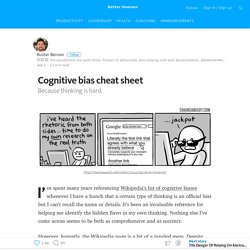
You don’t have to. But you can start by remembering these four giant problems our brains have evolved to deal with over the last few million years (and maybe bookmark this page if you want to occasionally reference it for the exact bias you’re looking for): Information overload sucks, so we aggressively filter.Lack of meaning is confusing, so we fill in the gaps.Need to act fast lest we lose our chance, so we jump to conclusions.This isn’t getting easier, so we try to remember the important bits. In order to avoid drowning in information overload, our brains need to skim and filter insane amounts of information and quickly, almost effortlessly, decide which few things in that firehose are actually important and call those out.
Can You Solve Einstein's Riddle? The following riddle is claimed to have been written by Einstein as a boy.
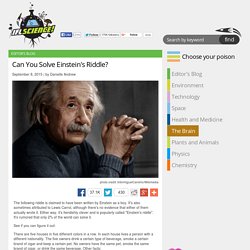
It's also sometimes attributed to Lewis Carrol, although there's no evidence that either of them actually wrote it. Either way, it's fiendishly clever and is popularly called "Einstein's riddle". Leaders as Decision Architects. All employees, from CEOs to frontline workers, commit preventable mistakes: We underestimate how long it will take to finish a task, overlook or ignore information that reveals a flaw in our planning, or fail to take advantage of company benefits that are in our best interests.

It’s extraordinarily difficult to rewire the human brain to undo the patterns that lead to such mistakes. Fueling doubt and openness: Experiencing the unconscious, constructed nature of perception induces uncertainty and openness to change. The American Journal of Bioethics - Volume 13, Issue 6. Rats and Humans Can Optimally Accumulate Evidence for Decision-Making. The gradual and noisy accumulation of evidence is a fundamental component of decision-making, with noise playing a key role as the source of variability and errors.
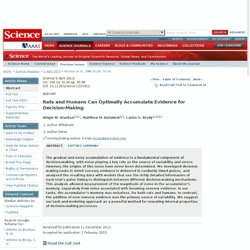
However, the origins of this noise have never been determined. We developed decision-making tasks in which sensory evidence is delivered in randomly timed pulses, and analyzed the resulting data with models that use the richly detailed information of each trial’s pulse timing to distinguish between different decision-making mechanisms.
This analysis allowed measurement of the magnitude of noise in the accumulator’s memory, separately from noise associated with incoming sensory evidence. In our tasks, the accumulator’s memory was noiseless, for both rats and humans. Observing the Observer (I): Meta-Bayesian Models of Learning and Decision-Making. Abstract In this paper, we present a generic approach that can be used to infer how subjects make optimal decisions under uncertainty.
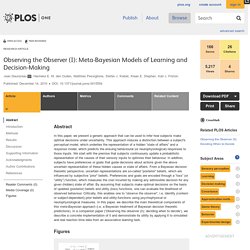
This approach induces a distinction between a subject's perceptual model, which underlies the representation of a hidden “state of affairs” and a response model, which predicts the ensuing behavioural (or neurophysiological) responses to those inputs. We start with the premise that subjects continuously update a probabilistic representation of the causes of their sensory inputs to optimise their behaviour. In addition, subjects have preferences or goals that guide decisions about actions given the above uncertain representation of these hidden causes or state of affairs. From a Bayesian decision theoretic perspective, uncertain representations are so-called “posterior” beliefs, which are influenced by subjective “prior” beliefs. Editor: Olaf Sporns, Indiana University, United States of America Copyright: © 2010 Daunizeau et al. Introduction Figure 1. .
Psych-www.colorado.edu/~tito/sp03/7536/becahra_et_al_1997.pdf. How Embodied Is Perceptual Decision Making? Evidence for Separate Processing of Perceptual and Motor Decisions. + Author Affiliations {*style:<ol style="padding-left:20px;"><li>
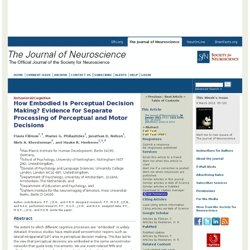
Interview with Daniel Kahneman on the Pitfalls of Intuition and Memory. Myths about Rationality on Psych Central. Rationality has been a popular topic of discussion for many years.
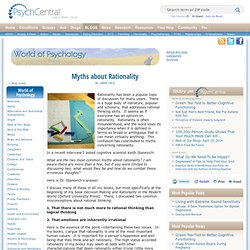
There is a huge body of literature, popular and scholarly, that addresses rational thinking skills. It seems as if everyone has an opinion on rationality. Rationality is often misunderstood, and the word loses its importance when it is defined in terms so broad or ambiguous that it can mean virtually anything. This confusion has contributed to myths concerning rationality. In a recent interview I asked cognitive scientist Keith Stanovich: What are the two most common myths about rationality? Here is Dr. Researchers determine region of the brain necessary for making decisions about economic value. Neuroeconomic research at the University of Pennsylvania has conclusively identified a part of the brain that is necessary for making everyday decisions about value.
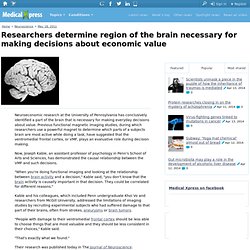
Previous functional magnetic imaging studies, during which researchers use a powerful magnet to determine which parts of a subjects brain are most active while doing a task, have suggested that the ventromedial frontal cortex, or VMF, plays an evaluative role during decision making. Now, Joseph Kable, an assistant professor of psychology in Penn's School of Arts and Sciences, has demonstrated the causal relationship between the VMF and such decisions.
"When you're doing functional imaging and looking at the relationship between brain activity and a decision," Kable said, "you don't know that the brain activity is causally important in that decision. They could be correlated for different reasons. "